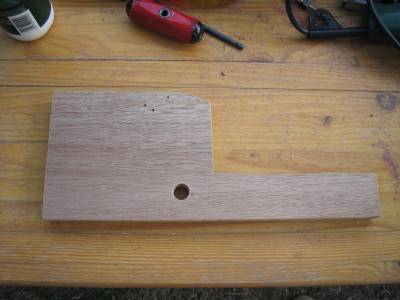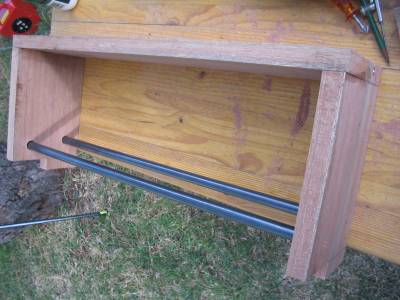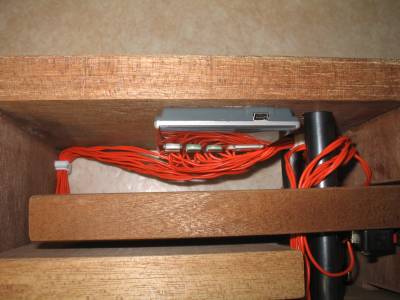Footboard: A 16 pedal USB Input Device
I thought it would be useful to operate a computer with my feet. This page describes how I went about building something which lets me do this.
Components
- Wood
- Metal Tubing
- Microswitches
- Wire
- USB calculator or numeric keypad
- Screws, Glue and Solder
Equipment
- Saw
- Drill
- Soldering Iron
- Screw Driver
- ...
Step 1: The Pedals
The pedals I constructed are not spring loaded, instead gravity returns them to their open position.

So one needs a bit of weight (wood) off the center of the rotational axis.
Step 2: The Box
Something needs to hold the pedals.

Eight pedals turn around each of the two metal tubes.
Step 3: The Electronics
I managed to get hold of a calculator which has a USB interface. I would imagine a USB keypad or even keyboard would also have worked. I
- Disassembled the calculator
- Removed the keys and membrane of the keypad
- Soldered pairs of wire to the contact patches under the membrane. I used a small hacksaw blade to expose the tracks on the PCB
- Threaded the wires through the holes left by the removed keys and closed up the calculator

Step 4: Assembly
Wiring up the pedals to the calculator was a bit more complex than anticipated. I had not made provisions for the large number of wires, so I had to thread some of the wires through the pedals. Fortunately the switches did fit into the box.
The Result

Software
To a PC the calculator looks like a keypad. In order to generate all the other keys I hacked up a custom linux keymap which repurposed the sticky and meta keys. This map makes it possible to generate most characters with two pedal presses. Exceptions are arrow, enter and erase keys - they can be generated with one keystroke. The two stroke mapping is shown below. To generate a key, locate the desired character and read the leftmost field in its row. Then locate this pedal and press it before pressing the pedal labelled with the desired character.
# CAPS LFT BS DWN UP RGT SP CHR2
# CHR12: bw vx cd qk zj %^ ?! i
# PCT12: <> @# ,. PgUD ScUD [] ()
# NUM : ` - ' + 9 8 7
# VC : v5 v6 v7 v8 v9 v10 v11 v12
#
# RET NUM PCT1 PCT2 VC CTL1 CTL2 CHR2
# CHR12: tm eh sp og ry nf au l
# PCT12: |& {} \ : =; $* ~" /_
# NUM : 0 1 2 3 4 5 6
# VC : v4 vc+ vc- prv v1 v2 v3
This keymap can probably also be used with a normal
keyboard, although some minor modifications
may be needed. But it should be good enough to
type with one hand without having to patch the
kernel. The keymap can be downloaded
here.
Use loadkeys to load it into the console.
Some Experiences
It is quite slow. Two leg movements per symbol take a lot longer than one finger movement. Memorising the layout also takes time. With practice it probably will get faster.
One needs a chair of a certain height to operate the device comfortably. Even then it is a bit awkward - the legs tend to dangle.
The wood I used wasn't quite uniform and my workmanship not completely exact. The net effect is that each pedal has a slightly different feel - on a good day this could be a feature rather than a bug.
I did not pay sufficient attention when drilling the holes in the pedals. Some are not quite at right angles to the surface, resulting in a bit of play and one or two keys sticking when the pedals move sideways on rotation.
The poor calculator occasionally gets confused and hangs. I suppose this is unsurprising, the large amounts of extra wiring probably acts as some sort of inductor.
But it does work and makes a rather nice clunky sound.
up to projects